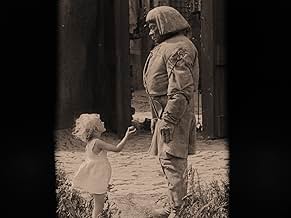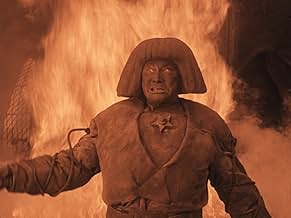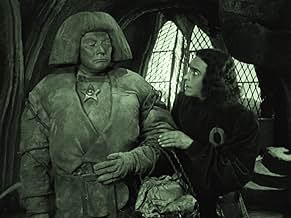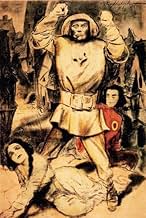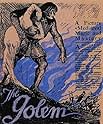CALIFICACIÓN DE IMDb
7.2/10
9.2 k
TU CALIFICACIÓN
En la Praga del siglo XVI, un rabino crea un Golem, una criatura hecha de barro. Por medio de la brujería, hace que la criatura cobre vida para proteger a los judíos de Praga de ser persegui... Leer todoEn la Praga del siglo XVI, un rabino crea un Golem, una criatura hecha de barro. Por medio de la brujería, hace que la criatura cobre vida para proteger a los judíos de Praga de ser perseguidos.En la Praga del siglo XVI, un rabino crea un Golem, una criatura hecha de barro. Por medio de la brujería, hace que la criatura cobre vida para proteger a los judíos de Praga de ser perseguidos.
- Dirección
- Guionistas
- Elenco
- Premios
- 1 premio ganado y 1 nominación en total
Hans Stürm
- Der Rabbi Jehuda, der Älteste der Gemeinde
- (as Hans Sturm)
Carl Ebert
- Temple Servant
- (sin créditos)
Fritz Feld
- Jester
- (sin créditos)
Loni Nest
- Ein kleines Mädchen
- (sin créditos)
- …
Ursula Nest
- Little Girl
- (sin créditos)
Dore Paetzold
- Des Kaisers Kebse
- (sin créditos)
- …
Märte Rassow
- Kind
- (sin créditos)
- Dirección
- Guionistas
- Todo el elenco y el equipo
- Producción, taquilla y más en IMDbPro
Opiniones destacadas
"Der Golem" is surely one of the best German expressionist silent movies. It may be second only to "The Cabinet of Doctor Caligari"; I enjoyed it as much as Murnau's "Faust", and, truth be told, more than "Nosferatu".
You probably already know the story: it's a well-known Jewish folk tale about a rabbi who constructs a stone creature (a golem) to protect his fellows from an anti-Semitic government in medieval Prague. The creature impresses the gentiles, but then it turns on its master.
These movies aren't really about plot, nor characters. They're about mood, setting, and mise-en-scene. The golem itself is an indelible image; surprisingly it was played by the writer-director himself, who must have been a massive person. You can see the influence on James Whale's classic "Frankenstein". The settings are also sumptuous and fitting.
My mind did wander, but not as much as when I watched Swedish silent "Korkarlen", also a horror film based on local myth. I appreciated that the story was easy to follow and interesting.
You probably already know the story: it's a well-known Jewish folk tale about a rabbi who constructs a stone creature (a golem) to protect his fellows from an anti-Semitic government in medieval Prague. The creature impresses the gentiles, but then it turns on its master.
These movies aren't really about plot, nor characters. They're about mood, setting, and mise-en-scene. The golem itself is an indelible image; surprisingly it was played by the writer-director himself, who must have been a massive person. You can see the influence on James Whale's classic "Frankenstein". The settings are also sumptuous and fitting.
My mind did wander, but not as much as when I watched Swedish silent "Korkarlen", also a horror film based on local myth. I appreciated that the story was easy to follow and interesting.
Although this 1920 German silent does not really rank alongside the truly great silent films, it remains a fascinating oddity. Based on European Jewish folklore, it tells the story a Jewish community in Prague which is threatened with expulsion from the city. In an effort to protect his people, Rabbi Loew creates a man-like creature made of clay and uses it to impress the Emperor. Unfortunately, the magic backfires, and when the Golem falls into the hands of the Rabbi's perfidious assistant disaster results.
Much of the film's charm is in its visual style. The sets by Hans Poelzig are a strange but cohesive mixture of medieval, nouveau, and surrealism, and the cinematography by legendary photography Karl Freund uses high contrast black and white to truly remarkable effect. The Poelzig-Freund combination would cast an extremely long shadow, and THE GOLEM would influence not only such German films as Fitz Lang's METROPOLIS but the entire cycle of 1930s American horror films that began with the 1931 Bela Lugosi Dracula.
Several plot devices and the look of the Golem, as played by Paul Wegener, would also prove particularly influential for director James Whale's famous 1932 FRANKENSTEIN. Whether or not Boris Karloff or make-up artist Jack Pierce knew the film is uncertain--but Whale, who was fond of German cinema, certainly did, and traces of THE GOLEM can be seen throughout his most famous works.
Over the past several decades a number of film historians have attempted to reinterpret THE GOLEM in light of the Holocaust. There may actually be a certain validity to this, for although the Jews are portrayed sympathetically they are very clearly outsiders, and their religion seems less like religion than witchcraft--and indeed Rabbi Loew might be said to practice black magic in bringing the Golem to life. This sense of social estrangement and religious stigmatism does seem indicative of the anti-Semitism that will ultimately explode into furnaces of Nazi Germany. All the same, it is worth noting that THE GOLEM is a fundamentally Jewish story to begin with, and it is perhaps best to think of it in those terms instead of using hindsight to impose modern meanings upon the film.
There are several home market releases of the film. While I have not seen it, I am told the Timeless Studios VHS release is weak; I have, however, seen the Gotham DVD release, and although there are some quality issues this inexpensive DVD is not at all bad. Still, my preference and recommendation is the Kino DVD. Unlike many Kino editions, it does not have anything significant in the way of bonuses, but the overall presentation is very fine and likely represents a best-possible presentation short of full digital restoration.
Much of the film's charm is in its visual style. The sets by Hans Poelzig are a strange but cohesive mixture of medieval, nouveau, and surrealism, and the cinematography by legendary photography Karl Freund uses high contrast black and white to truly remarkable effect. The Poelzig-Freund combination would cast an extremely long shadow, and THE GOLEM would influence not only such German films as Fitz Lang's METROPOLIS but the entire cycle of 1930s American horror films that began with the 1931 Bela Lugosi Dracula.
Several plot devices and the look of the Golem, as played by Paul Wegener, would also prove particularly influential for director James Whale's famous 1932 FRANKENSTEIN. Whether or not Boris Karloff or make-up artist Jack Pierce knew the film is uncertain--but Whale, who was fond of German cinema, certainly did, and traces of THE GOLEM can be seen throughout his most famous works.
Over the past several decades a number of film historians have attempted to reinterpret THE GOLEM in light of the Holocaust. There may actually be a certain validity to this, for although the Jews are portrayed sympathetically they are very clearly outsiders, and their religion seems less like religion than witchcraft--and indeed Rabbi Loew might be said to practice black magic in bringing the Golem to life. This sense of social estrangement and religious stigmatism does seem indicative of the anti-Semitism that will ultimately explode into furnaces of Nazi Germany. All the same, it is worth noting that THE GOLEM is a fundamentally Jewish story to begin with, and it is perhaps best to think of it in those terms instead of using hindsight to impose modern meanings upon the film.
There are several home market releases of the film. While I have not seen it, I am told the Timeless Studios VHS release is weak; I have, however, seen the Gotham DVD release, and although there are some quality issues this inexpensive DVD is not at all bad. Still, my preference and recommendation is the Kino DVD. Unlike many Kino editions, it does not have anything significant in the way of bonuses, but the overall presentation is very fine and likely represents a best-possible presentation short of full digital restoration.
Imagine shooting a feature-length horror movie with the camera built into your mobile phone. Now imagine disabling sound and colour on your phonecam, only being able to shoot a few seconds at a time, each minute costing a small fortune in recording material, imagine that phonecam being large and unwieldy and kind of knackered so that the already low-resolution image is flickery and erratically exposed, and it plays back too fast so that people look like wound-up dolls. It also exposes blueish light more than reddish light, so each shoot is unpredictable, but of course you'll only know that the next day when the film has been processed.
Welcome to movie-making in the year 1920 AD.
Now go shoot a masterpiece that will still be watched, talked about and revered in a hundred years.
I watched this out of historic interest and expected to be colossally bored. But far from it, this is actually a gripping horror flick, and one with a deep side to it to boot. The Golem himself is an immensely scary horror figure en par with Freddy Kruger or the Alien, kind of a proto-Frankenstein's monster -- and he's actually played by director Paul Wegener himself!. I'd like to know how they made his eyes so scary.
Anyway, what can I say, a stupendous film. Watch it from the edge of your seat.
Welcome to movie-making in the year 1920 AD.
Now go shoot a masterpiece that will still be watched, talked about and revered in a hundred years.
I watched this out of historic interest and expected to be colossally bored. But far from it, this is actually a gripping horror flick, and one with a deep side to it to boot. The Golem himself is an immensely scary horror figure en par with Freddy Kruger or the Alien, kind of a proto-Frankenstein's monster -- and he's actually played by director Paul Wegener himself!. I'd like to know how they made his eyes so scary.
Anyway, what can I say, a stupendous film. Watch it from the edge of your seat.
At the beginning of the DvD's "scrapbook", there is a quote from Paul Wegener that says he never thought the Golem was an expressionist film. Watching it right after seeing Nosferatu, that statement becomes believable. Despite amazing sets that would have been at home in Caligari, in story, in acting, and in overall tone, The Golem is a much more naturalistic film. Watching it with my son, who is 16, he was struck by its uncomfortable prefiguring of Jewish persecution. I was impressed by the the scarcity of romantic cliches in the story. The golem itself is clearly the ancestor of the Frankenstein monster. Full of wonderful images and interesting as a predecessor of the Universal monster films, The Golem is also very entertaining as a story and as a piece of dramatic film making. Highly recommended.
In 16th-century Prague, a Jewish rabbi (Albert Steinrück) creates a giant creature from clay, called the Golem, and using sorcery, brings the creature to life in order to protect the Jews of Prague from persecution.
Called "one of the most ambitious productions of the silent era" by Mike Mayo, the film is a blend of religion, astrology and black magic -- mixing Judaism with a conjuring of the demon Astaroth.
The film also has an interesting presentation of anti-Semitism, where the emperor accuses the Jews of killing Christ, among other things, and orders them to evacuate the ghetto. How did Germany in 1920 feel about the Jews? We now know how they felt a decade later, but was this hatred always there or invented by Hitler? If it existed, how did it translate to this film's reception by the German people?
Paul Wegener's face is a wealth of visions -- he manages to use his eyes in such a way that present the golem as simultaneously stoic and intensely emotional.
Others have pointed out that Karl Freund's camera is remarkably still for a man who would go on to be known for the most innovative camera techniques in film history (I dare say he is the greatest cinematographer who ever lived). Mayo says there is an "inventive use of extreme camera angles", but I did not notice. The lack of movement does not hinder the film, however.
Lee Price praises the film, saying the only fault of the film is "the inconsistency of the acting", though I did not find it distracting at all (even if the frightened faces of the extras are a bit extreme). Price calls the architecture of the film as influential (or more so) than the German Expressionism of "Caligari". He is not alone in this view: Ivan Butler makes a point to mention the "strange twisted buildings and crooked streets filled with steeple-hatted inhabitants", and Siegfried Kracauer singles out the "maze of crooked streets and stooped houses" devised by Professor Hans Poelzig.
If you are to see or own this film, I recommend the Kino DVD. Not only is the film cleaned up nicely, with a wonderful score and English title cards, but the supplements are beyond what one would expect from such an old film -- featurettes comparing this movie to "Faust" and the later "Le Golem". I enjoyed them.
Called "one of the most ambitious productions of the silent era" by Mike Mayo, the film is a blend of religion, astrology and black magic -- mixing Judaism with a conjuring of the demon Astaroth.
The film also has an interesting presentation of anti-Semitism, where the emperor accuses the Jews of killing Christ, among other things, and orders them to evacuate the ghetto. How did Germany in 1920 feel about the Jews? We now know how they felt a decade later, but was this hatred always there or invented by Hitler? If it existed, how did it translate to this film's reception by the German people?
Paul Wegener's face is a wealth of visions -- he manages to use his eyes in such a way that present the golem as simultaneously stoic and intensely emotional.
Others have pointed out that Karl Freund's camera is remarkably still for a man who would go on to be known for the most innovative camera techniques in film history (I dare say he is the greatest cinematographer who ever lived). Mayo says there is an "inventive use of extreme camera angles", but I did not notice. The lack of movement does not hinder the film, however.
Lee Price praises the film, saying the only fault of the film is "the inconsistency of the acting", though I did not find it distracting at all (even if the frightened faces of the extras are a bit extreme). Price calls the architecture of the film as influential (or more so) than the German Expressionism of "Caligari". He is not alone in this view: Ivan Butler makes a point to mention the "strange twisted buildings and crooked streets filled with steeple-hatted inhabitants", and Siegfried Kracauer singles out the "maze of crooked streets and stooped houses" devised by Professor Hans Poelzig.
If you are to see or own this film, I recommend the Kino DVD. Not only is the film cleaned up nicely, with a wonderful score and English title cards, but the supplements are beyond what one would expect from such an old film -- featurettes comparing this movie to "Faust" and the later "Le Golem". I enjoyed them.
¿Sabías que…?
- Trivia"Aemaet", the life-giving word which Rabbi Lowe compels from the spirit Astaroth is also reflected in the bolts of lightning at the end of the creation scene.
- ErroresThe story is set in the 16th Century. A prediction of doom is made based on the movements of Uranus, which was not discovered until 1781.
- Versiones alternativasThe 2002 Alpha Video DVD version runs for 101 minutes. This is not evident from the back of the Alpha Video DVD case, which wrongly lists the running time as only 85 minutes. It looks as if Alpha Video somehow got hold of the fullest version currently known - maybe even a complete version of the film, since there are no obvious gaps in the story.
- ConexionesEdited into People Who Die Mysteriously in Their Sleep (2004)
Selecciones populares
Inicia sesión para calificar y agrega a la lista de videos para obtener recomendaciones personalizadas
- How long is The Golem?Con tecnología de Alexa
Detalles
- Tiempo de ejecución
- 1h 16min(76 min)
- Color
- Mezcla de sonido
- Relación de aspecto
- 1.33 : 1
Contribuir a esta página
Sugiere una edición o agrega el contenido que falta


